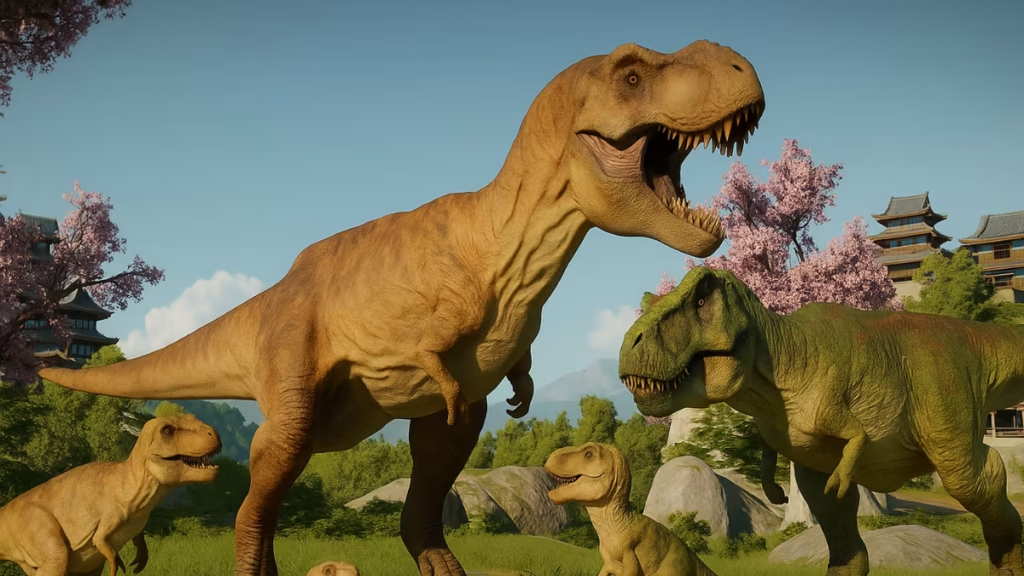The third entry in Frontier’s Jurassic World Evolution series doesn’t just let you manage a dinosaur park — it lets you grow one, quite literally. With the introduction of breeding, baby dinosaurs, and new genetic systems, Jurassic World Evolution 3 transforms your park into a living ecosystem that evolves before your eyes.

How the New Breeding System Works in Jurassic World Evolution 3
Jurassic World Evolution 3 expands the simulation far beyond fossil synthesis. For the first time, dinosaurs can naturally reproduce, producing juveniles that inherit genetic traits from their parents.
There are two distinct paths to creating new life in your park — the Hatchery and the Nesting Area. Both lead to the same outcome (baby dinosaurs), but how you get there determines how much control you have over the result.
Gtheos 2.4GHz Wireless Gaming Headset – White
See also: All Dinosaurs in Jurassic World Evolution 3 – Full List of Every Species and Hybrid
How to Use the Hatchery for Dinosaur Breeding
If you prefer precision and control, the Hatchery is your go-to method.
Attach a Hatchery directly to the enclosure where you want breeding to occur, ensuring the gate opens inward so your newborns stay secure. Once your dinosaurs meet their mating conditions, your scientists can initiate incubation.
Step-by-Step:
- Select a compatible male and female pair.
- Use scientists to synthesize and incubate fertilized eggs.
- Adjust genome traits before incubation — you can alter sex, colors, and even behavioral traits.
- After incubation, release the juvenile manually into the enclosure.
Why choose the Hatchery?
Because it gives you complete control. You can guarantee rare male offspring, filter out aggressive genes, or breed for stronger fertility rates — all of which help fine-tune park management and stability.
The Nesting Area: Let Nature Do the Work
If you’d rather let life find its own way, set up a Nesting Area inside your enclosure. When conditions are right — comfortable habitat, fertile adults, and enough space — your dinosaurs will begin breeding naturally.
Key Details:
- Nests are species-specific; use Ranger Teams to identify what each dinosaur prefers.
- Eggs are incubated in the wild and hatch directly into juveniles.
- Traits are inherited randomly — you’ll have less control but a more organic ecosystem.
Why choose the Nesting Area?
It offers a more authentic experience. You’ll see social behavior evolve naturally, and your park will feel more alive as families form and species interact across generations.
Meeting Breeding Requirements
Dinosaurs won’t breed unless every requirement is satisfied. Check these before starting:
| Requirement | Description |
|---|---|
| Male & Female Pair | You need both genders. Males are rarer and may need to be synthesized or captured. |
| Fertility Rating | Each species has unique fertility stats that affect breeding success. |
| Compatibility | Some species simply don’t pair well — check their social preferences. |
| Comfort Level | Unhappy or stressed dinosaurs won’t mate. Keep their environment ideal. |
| Space & Territory | Ensure enclosures are large enough for both adults and juveniles. |
| Nesting/Hatchery Access | Without a functional breeding structure, mating won’t initiate. |
Maintaining comfort and space isn’t just about breeding success — it also prevents aggression and overcrowding once your hatchlings start to grow.
Raising Juvenile Dinosaurs
Baby dinosaurs in JWE3 are more than adorable — they’re a key factor in park growth and guest engagement. Visitors are drawn to these tiny versions of prehistoric giants, and well-designed viewing areas around hatcheries can significantly increase park appeal and revenue.
Tips for Managing Juveniles:
- Prepare Before Hatching: Expand enclosure space in advance — juveniles grow quickly.
- Adjust Feeding Stations: Provide accessible food and water suited to smaller creatures.
- Secure Fencing: Juveniles can slip through gaps adults can’t. Reinforce containment.
- Health Monitoring: Use Ranger Teams to scan newborns early for genetic illnesses.
- Balanced Exhibits: Mix adult and juvenile species for variety and realism in guest areas.
Breed Stronger Dinosaurs
Once you’ve mastered basic breeding, it’s time to experiment. The Hatchery system allows direct genome editing before incubation, while traits can also be selectively passed through generations.
Advanced Strategies:
- Trait Filtering: Breed for high fertility, longer lifespan, or calmer temperaments.
- Hybrid Creation: Combine genetic data from fossils or other species for unique variants.
- Controlled Breeding Programs: Prevent aggressive or unstable traits from spreading.
- Ecosystem Planning: Use structured breeding to maintain balanced populations.
As Frontier developers hinted, “You might not want to breed aggression down through generations.” Careful curation ensures your park remains both safe and profitable. Play Now!
Read More:
More Gaming Guides
- 01FC 26 Frostbite Finisher Evolution Best Players – Top Strikers to Upgrade
- 02Where to Find Advanced Electrical Components in ARC Raiders
- 03All Wishblossom Ranch Recipes in Disney Dreamlight Valley
- 04How to Find Tomo’s Lost Cat in The Forge – Complete Quest Walkthrough
- 05Diablo 4 Goblin Event Rewards and Loot Guide
- 0610 Best Minecraft Pocket Edition Seeds to Try Right Now
- 07Arknights Endfield Release Date, Platforms, Gameplay, and What to Expect
- Escape From Duckov Beginner Tips & Tricks: How to Survive Your First Raids
- How Many Chapters Are in Ninja Gaiden 4 and Time to Beat
- How to Get the Soothe Bell in Pokemon Legends Z-A
- Best Vampire Bloodlines 2 Graphics Settings for Max FPS
- Nintendo Direct October 2025 Announced — Full Kirby Air Riders Showcase Revealed
- Best Ninja Gaiden 4 Graphics Settings for Maximum FPS
- Pokémon Legends Z-A Wish Choice Explained


